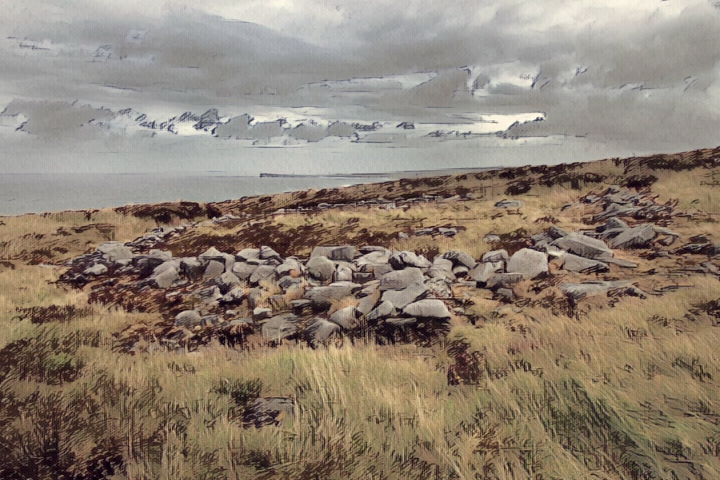The Céide Fields is an archaeological site located on the north County Mayo coast in the west of Ireland. It is considered to be the most extensive Neolithic site in Ireland and is believed to contain the oldest known field systems in the world. Using various dating methods, it has been estimated that the creation and development of the Céide Fields dates back to approximately 5500 years ago, or around 3500 BCE, which is 2,500 years before this type of field system developed anywhere else in Europe. Some research has also suggested that the complex developed 3,000 years ago and is a “textbook example” of a Celtic field system.
The site was discovered in the 1930s by a schoolteacher named Patrick Caulfield, who noticed linear piles of rocks that were uncovered as he cut away some peat for fuel. Caulfield noted that the rocks must have been placed there by people, because their configuration was apparently unnatural and deliberate. The rocks were also positioned beneath the bog, which suggested they were there before the bog developed, implying a very ancient origin. The significance of this discovery was not fully understood until forty years later when Patrick’s son, Seamus, who had studied archaeology, began to investigate further. Investigations revealed a complex of fields, houses, and megalithic tombs concealed by the growth of blanket bogs over the course of many centuries.

To preserve the site and ensure the continuation of research, a simple method was used to explore the sub-bog walls. This involved the location and mapping of these hidden walls by probing with long T-shaped iron rods. The ensuing excavation of habitation sites and tombs revealed the way of life of people living 200 generations earlier. They were a community of farmers who cleared large areas of forest for use as farm land. Their main economy was cattle rearing but among them were also craftspeople and builders in both wood and stone.
It was discovered that these people arrived in a land with substantial forest cover. This was cleared to provide access to arable land and to provide building material and firewood. Palaeoecological research published in 1995 and 2001 indicated that the woodland cleared by the farmers was primarily pine and birch, and was cleared to create pasture for livestock. This clearance continued onward and outward away from the area in continuing procurement of firewood.
The climate at the time was much warmer, leading to almost year-round growth potential. Samples taken from the remains of trees found in the bog provided evidence of this. However, some changes led to the development of raised bogs and the transformation of the arable land into barren and unusable land. An ironpan has developed in the subsoil over the area of the Céide Fields. Seamus Caulfied has estimated that there is more that 100 km (62 mi) of stone wall hidden beneath the bog. The site is in UNESCO’s tentative list to gain World Heritage status.
